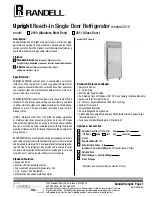
8
Connecting the Refrigerator
to a Water Source
Read all directions carefully before you begin.
IMPORTANT:
■
If operating the refrigerator before installing the water
connection, turn ice maker to the OFF position to
prevent operation without water.
■
All installations must be in accordance with local
plumbing code requirements.
■
Use copper tubing and check for leaks.
■
Install copper tubing only in areas where temperatures
will remain above freezing.
■
It may take up to 24 hours for your ice maker to begin
producing ice.
Tools required:
■
Standard screwdriver
■
⁷⁄₁₆
-inch and
¹⁄₂
-inch open-end wrenches or two
adjustable wrenches
■
¹⁄₄
-inch nut driver
■
¹⁄₄
-inch drill bit
■
Hand drill or electric drill (properly grounded)
NOTE: Your refrigerator dealer has a kit available with a
¹⁄₄
-inch saddle-type shut-off valve, a union, and copper
tubing. Before purchasing, make sure a saddle-type valve
complies with your local plumbing codes. Do not use a
piercing-type or
³⁄₁₆
-inch saddle valve which reduces water
flow and clogs more easily.
Cold Water Supply
The ice maker water valve contains a flow washer which is
used as a water pressure regulator. The ice maker needs to
be connected to a cold water line with water pressure
between 30 and 120 psi. If a problem occurs, call your
utility company.
Connecting to water line:
1. Unplug refrigerator or disconnect power.
2. Turn OFF main water supply. Turn ON nearest faucet
long enough to clear line of water.
3. Find a
¹⁄₂
-inch to 1
¹⁄₄
-inch vertical COLD water pipe
near the refrigerator.
NOTE: Horizontal pipe will work, but the following
procedure must be followed: Drill on the top side of the
pipe, not the bottom. This will help keep water away
from the drill. This also keeps normal sediment from
collecting in the valve.
4. To determine the length of copper tubing you will need,
measure from connection on lower left rear of
refrigerator to water pipe. Add 7 feet (2.1 m) to allow for
moving refrigerator for cleaning. Use
¹⁄₄
-inch O.D.
(outside diameter) copper tubing. Be sure both ends of
copper tubing are cut square.
5. Using a grounded drill, drill a
¹⁄₄
-inch hole in the cold
water pipe you have selected.
1. Cold Water Pipe
2. Pipe Clamp
3. Copper Tubing
4. Compression Nut
5. Compression Sleeve
6. Shut Off Valve
7. Packing Nut
6. Fasten shut-off valve to cold water pipe with pipe
clamp. Be sure outlet end is solidly in the
¹⁄₄
-inch drilled
hole in the water pipe and that washer is under the pipe
clamp. Tighten packing nut. Tighten the pipe clamp
screws carefully and evenly so washer makes a
watertight seal. Do not overtighten or you may crush
the copper tubing, especially if soft (coiled) copper
tubing is used. Now you are ready to connect the
copper tubing.
7. Slip compression sleeve and compression nut on
copper tubing as shown. Insert end of tubing into outlet
end squarely as far as it will go. Screw compression nut
onto outlet end with adjustable wrench. Do not
overtighten.
8. Place the free end of the tubing into a container or sink,
and turn ON main water supply and flush out tubing
until water is clear. Turn OFF shut-off valve on the water
pipe. Coil copper tubing.
Содержание 2200139A
Страница 31: ...31 WATER FILTER CERTIFICATIONS ...









































